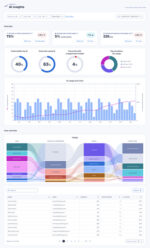
Some 98% of companies participating in Broadcom’s “Enterprise AI and the Data Problem” AI adoption survey say they are deploying AI solutions, yet challenges relating to data management, visibility, security and governance are hindering success.
“AI is delivering real business value, but it isn’t without its challenges,” Aline Gerew, head of automation for the Agile Operations Division at Broadcom, said in a statement announcing the survey results. “This survey cemented the critical importance of data quality, visibility, and resiliency for successful AI deployments. Those organizations that embrace data automation and orchestration as part of their AI initiatives will free up limited expert resources, address data security and governance concerns, and gain an important competitive advantage.”
Gerew indicated that in some aspects of AI deployment, Broadcom customers are seeing some successes with agentic AI, but she noted if they’re failing, it is largely around data orchestration and deployment. “I think that has been the struggle that they’re trying to work through,” she told SD Times in an interview. “It’s, how do they take all of these disparate tools that they’re using to move the data around, especially when it’s coming from various locations? It could be coming from the CRM or the ERP or the mainframe. So how did they bring that all together and orchestrate that data so it is there at the right time?”
The survey revealed that 42% of respondents cited accessing data from legacy systems as a top challenge, along with data pipelines (40%) and governance (45%). When it comes to data automation, the tasks most created by organizations are for data processing (62%), followed by refreshing data (58%) and real-time status (54%). These results, Broadcom noted, indicate that data quality and visibility are key requirements of any AI solution.
Perhaps the biggest measure of success involves the correlation between AI and data pipeline performance. Respondents reported that AI and data experts spend one-tenth or more of their time on data pipeline tools, while a third say it takes up more than a quarter of their day.
And, of course, as the data sources and AI deployments grow, these challenges will only get harder.
Broadcom’s Agile Operations Division, which Gerew is responsible for, looks to solve those challenges on two fronts. The first is what they call “powered by AI.” Broadcom is building AI into its own automation tools, so that – for instance – if an automated application fails to run to completion, they use their Ask AI tool to look at the log file, report on the error, and provide the best resolution for resolving that issue. “It’s still keeping the human in the loop,” she emphasized.
The company’s AI efforts also make it easier for application developers to use their tools to manage workflows. “How do you just use a chatbot to say… I want to run this application every Tuesday after some other application runs, and just put that in normal languages into the chatbot, and have it do all of the work for you,” Gerew said.
From “powered by AI,” Broadcom moves into “for AI,” in which outside organizations can use the automation products within their business. “If you think about agentic AI, most of that is just workflows,” Gerew said. “So how do you take your existing workflows that have been business workflows that you’ve had for many years, and start to insert AI capabilities into those workflows?”
It’s the ability to use Broadcom’s tooling to build AI agents that help organizations with their data orchestration, to help overcome what people think is the biggest hindrance to AI success.
“Organizations are bringing in cloud tools, data orchestration tools, but then there’s still that chaos that’s happening, because there is no centralized orchestration of all of those tools,” Gerew explained. “They’re not sure what’s running, what’s affected when something doesn’t run,
and many companies are still missing the fact that they can use their traditional workload automation and business process automation tools that they have today to orchestrate what they’re doing across the enterprise.”
These enterprises, she said, aren’t just operations and applications anymore. Now, there are data architecture groups and CDAOs (Chief Data and Artificial Intelligence Officers), and being able to bring all of that chaos together and organize it within their own automation tools is real.
Gerew likened what’s happening with AI today to what occurred when organizations raced to the cloud. “They started going off and using Google Cloud Composer for Airflow, or Databricks and whatever else. And they quickly realized they were missing SLAs. They had no visibility, and there was no organization to the chaos. So they started pulling it all together underneath their automation tools. And I think we’re starting to see that all over again.”







